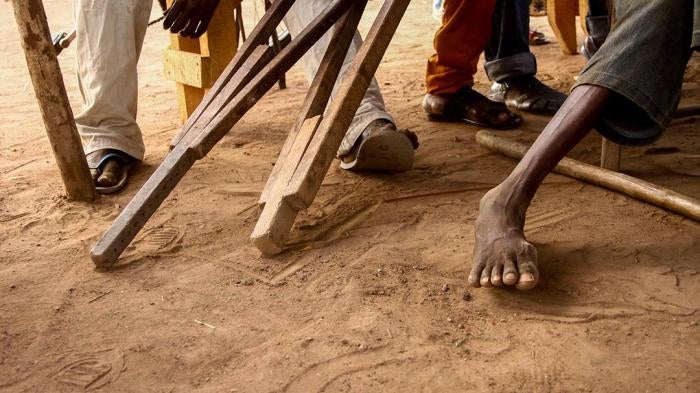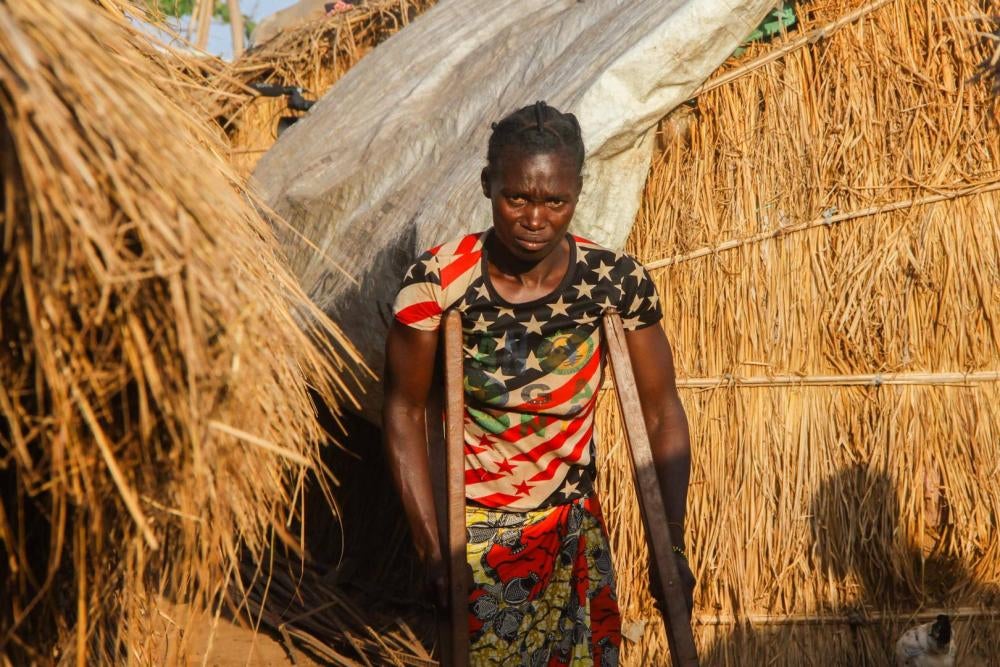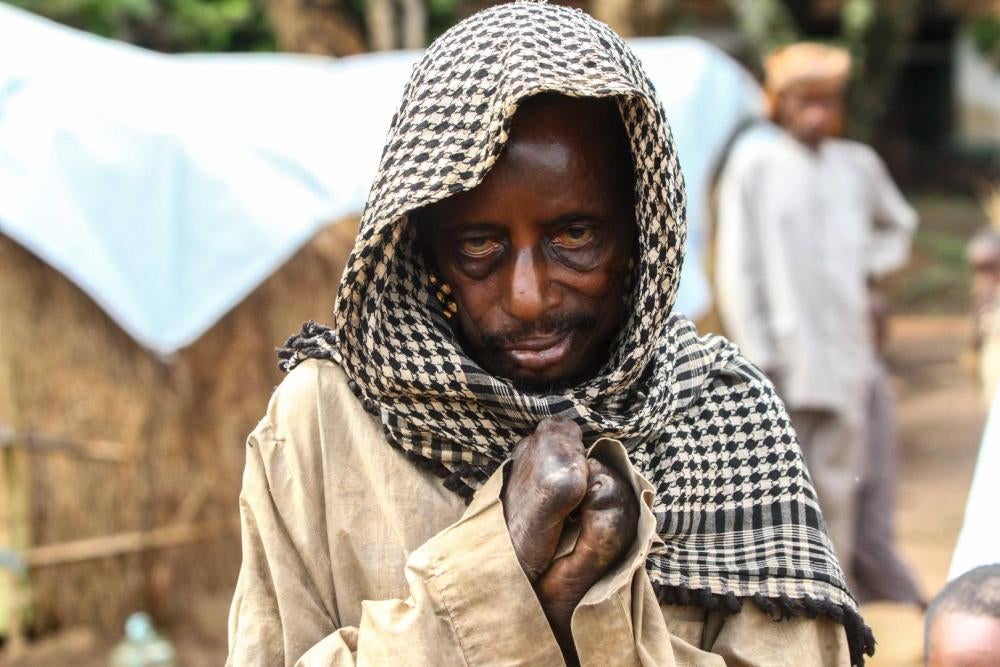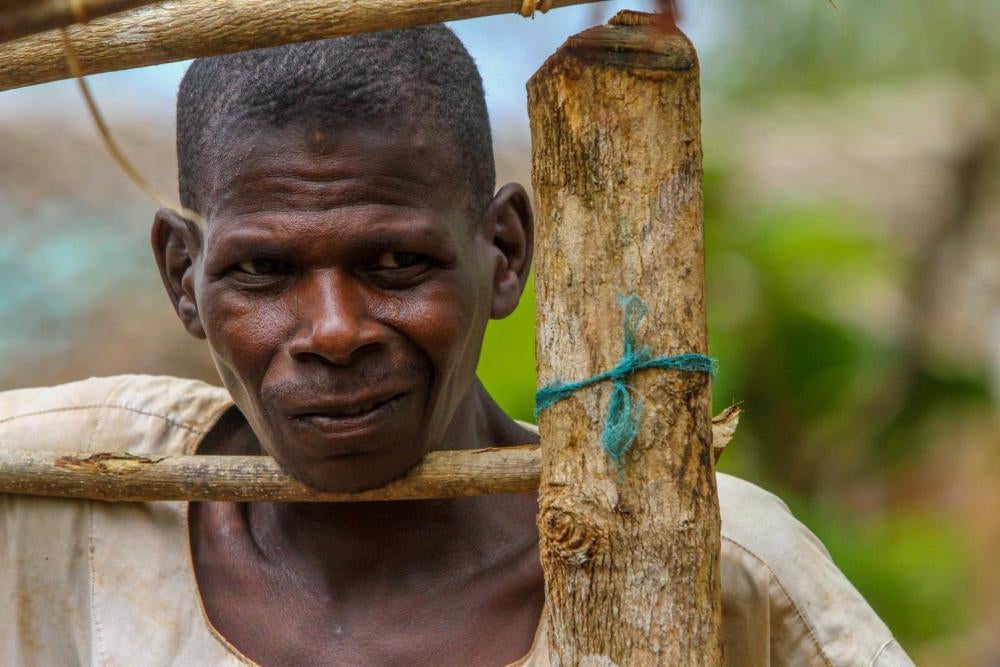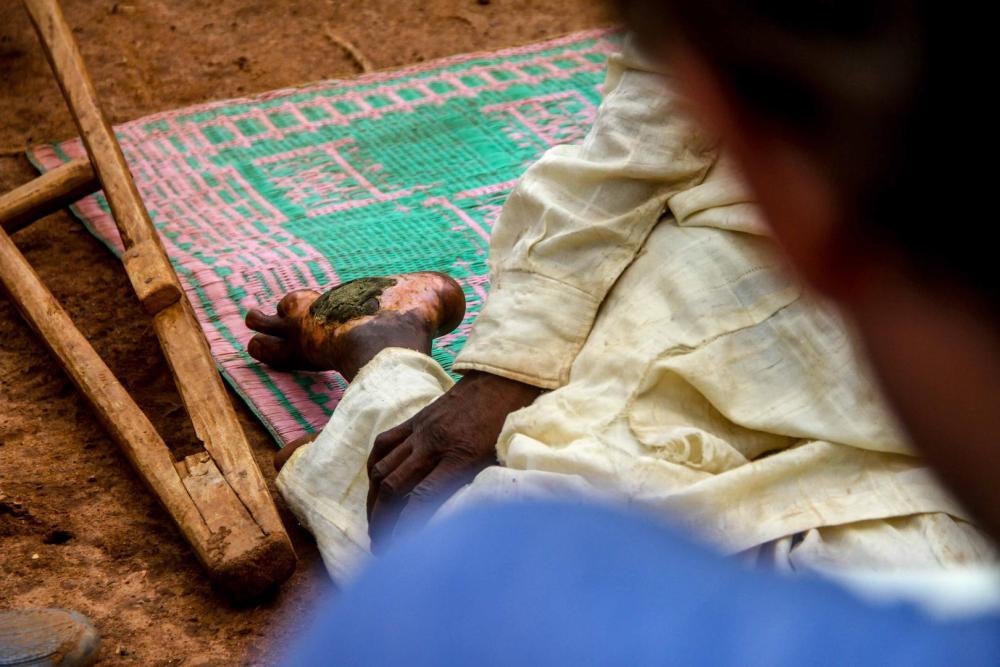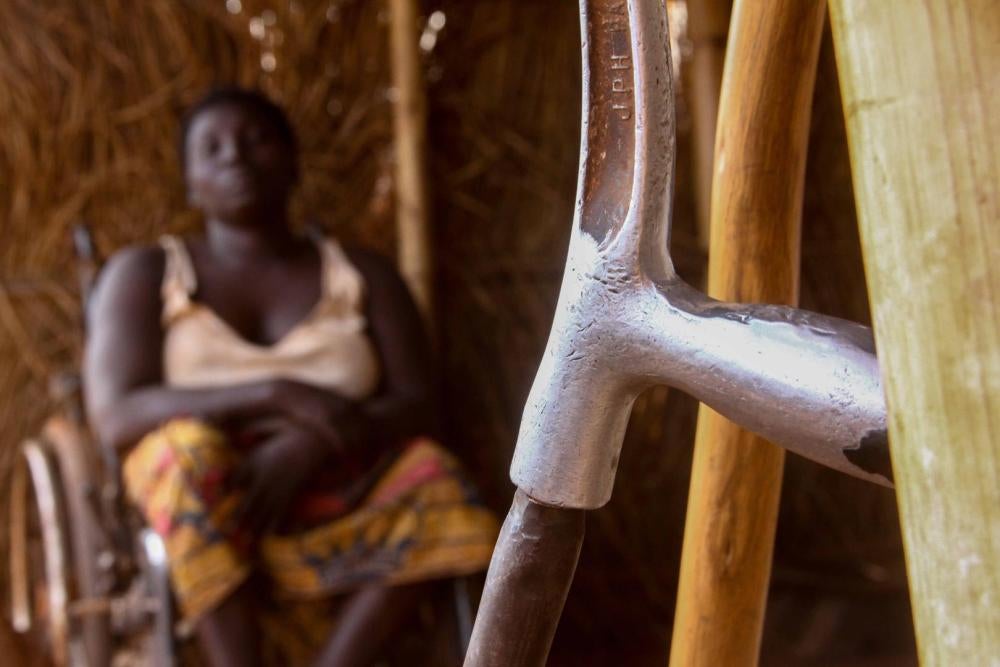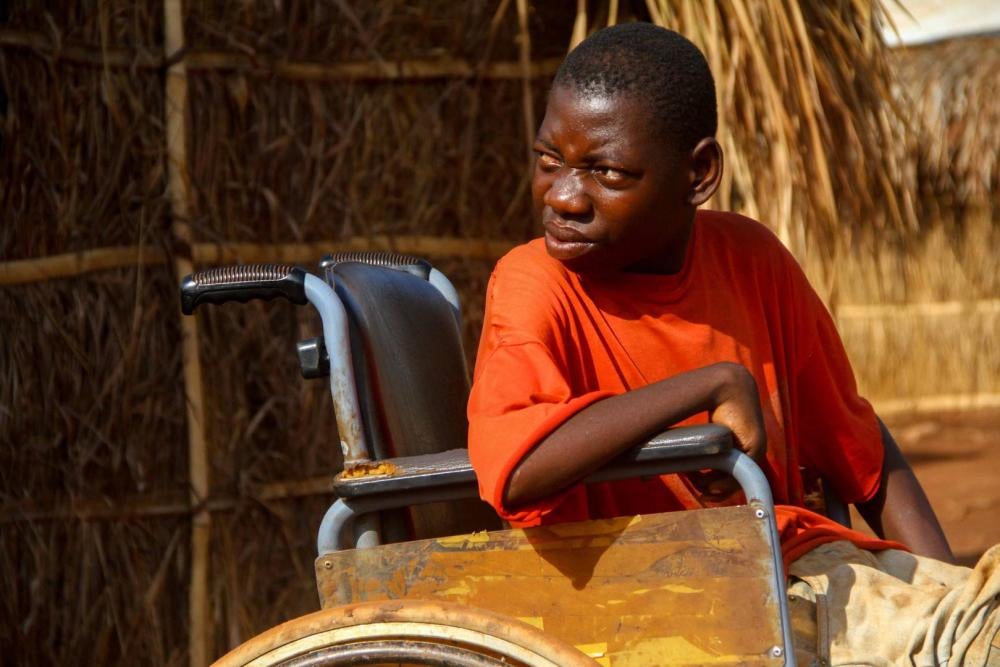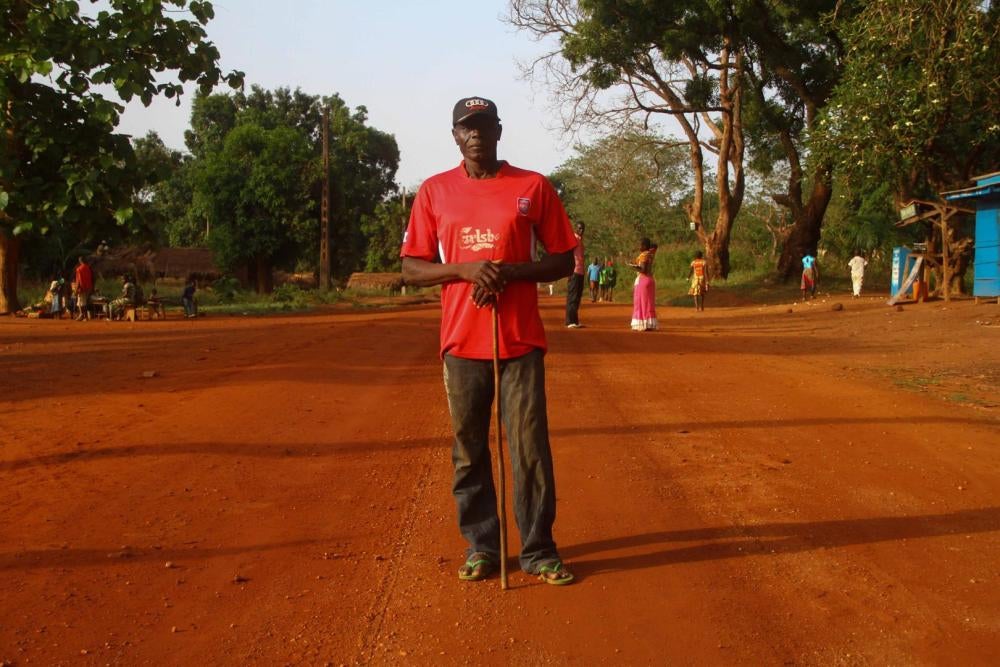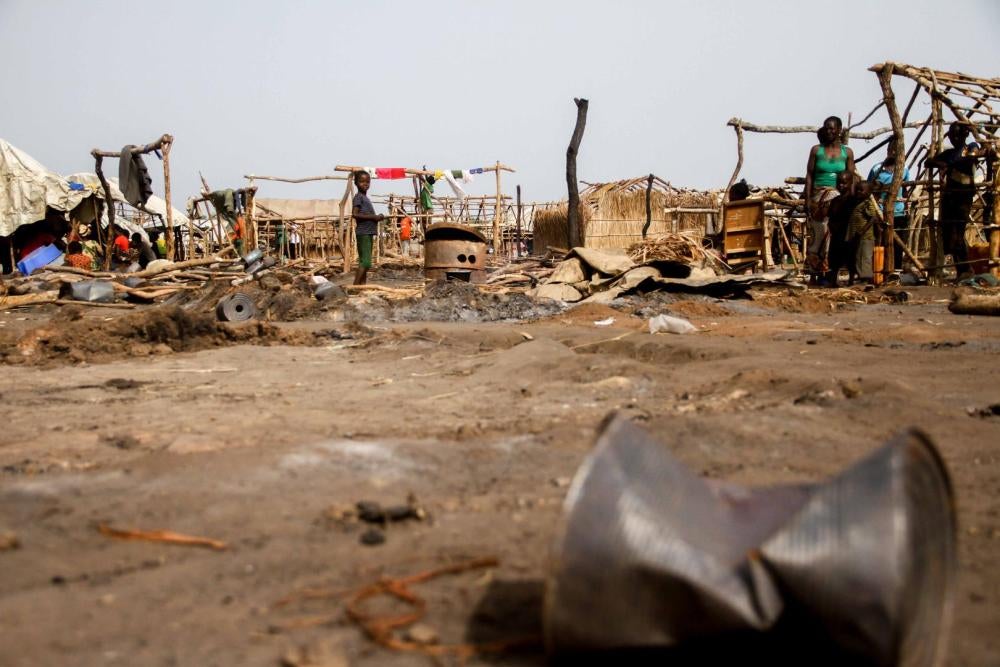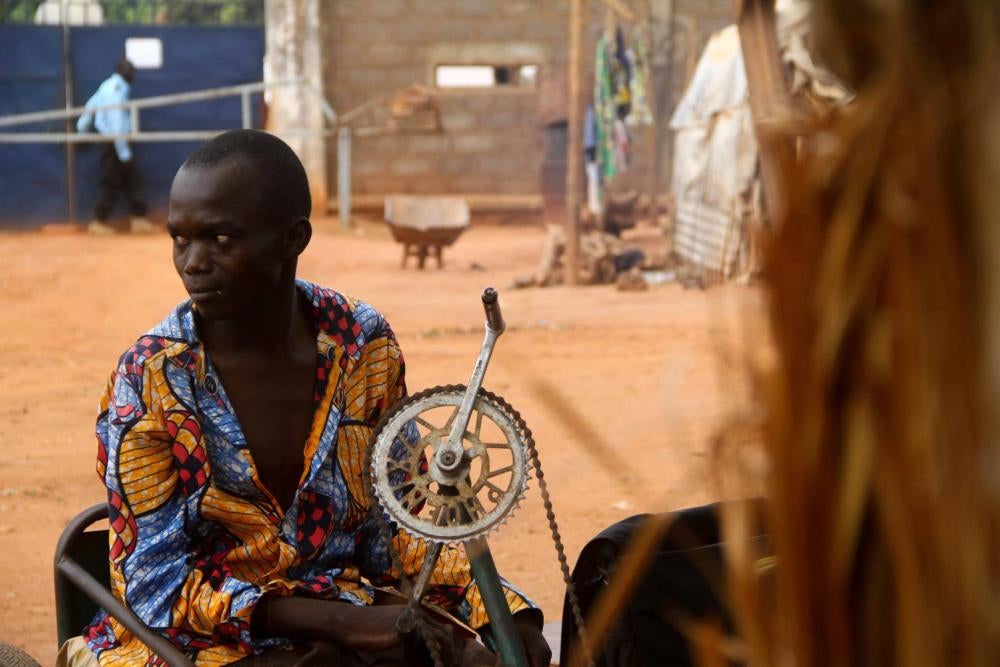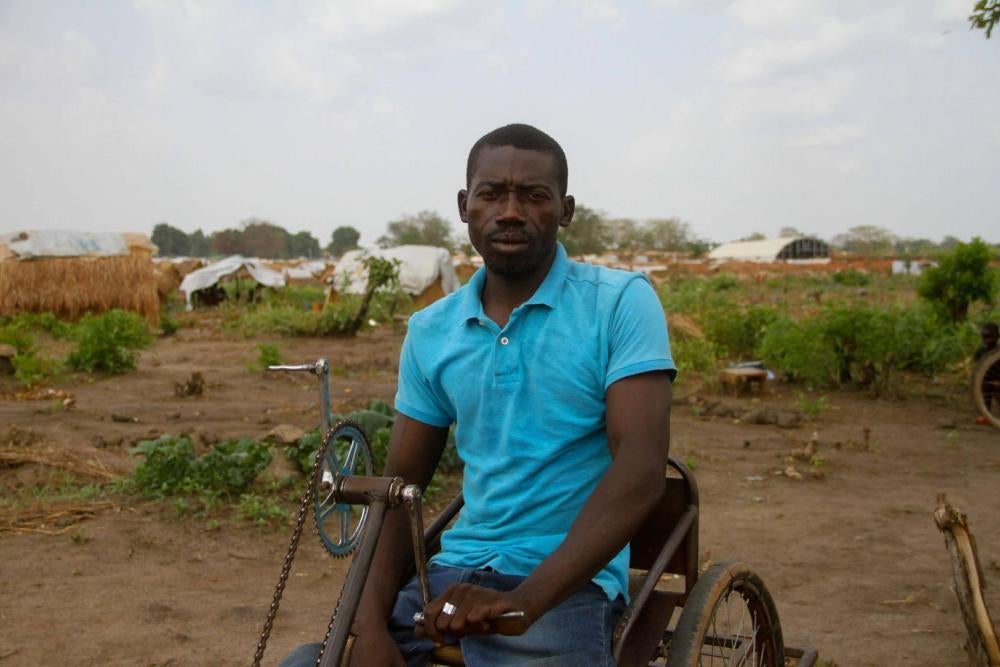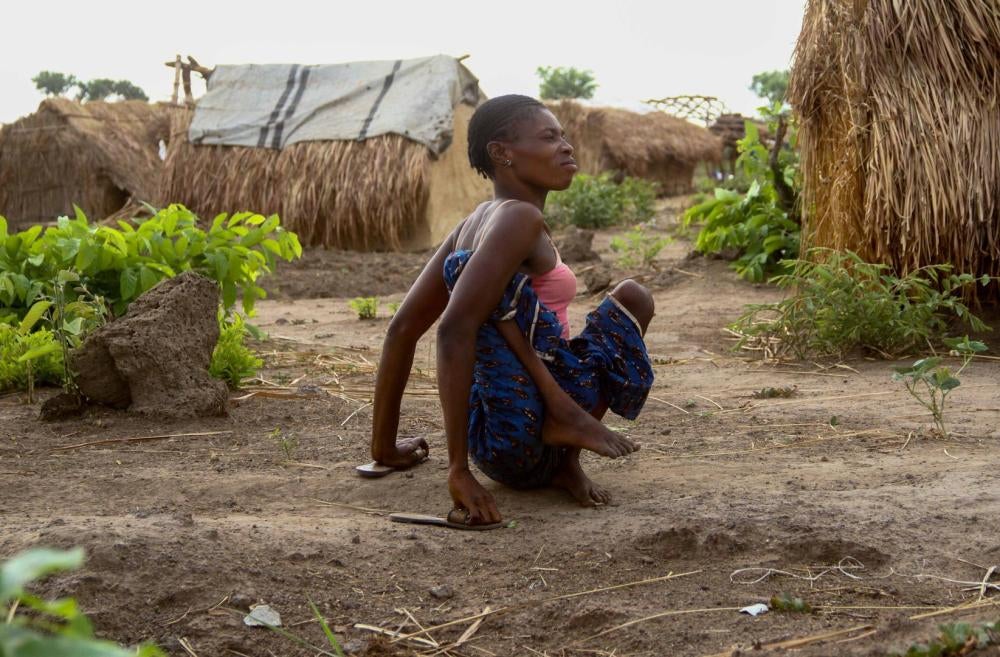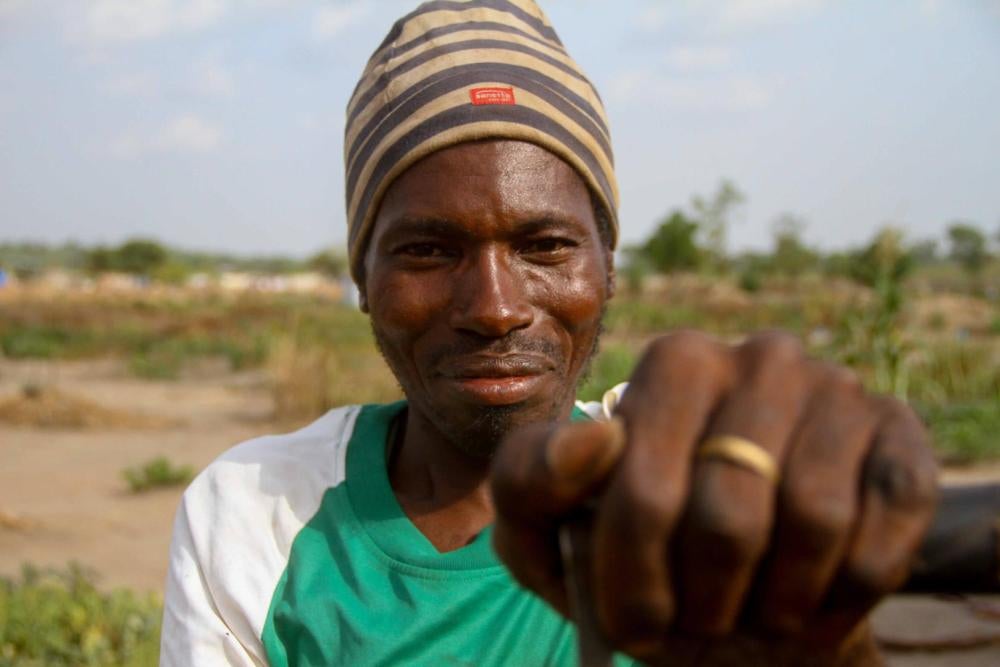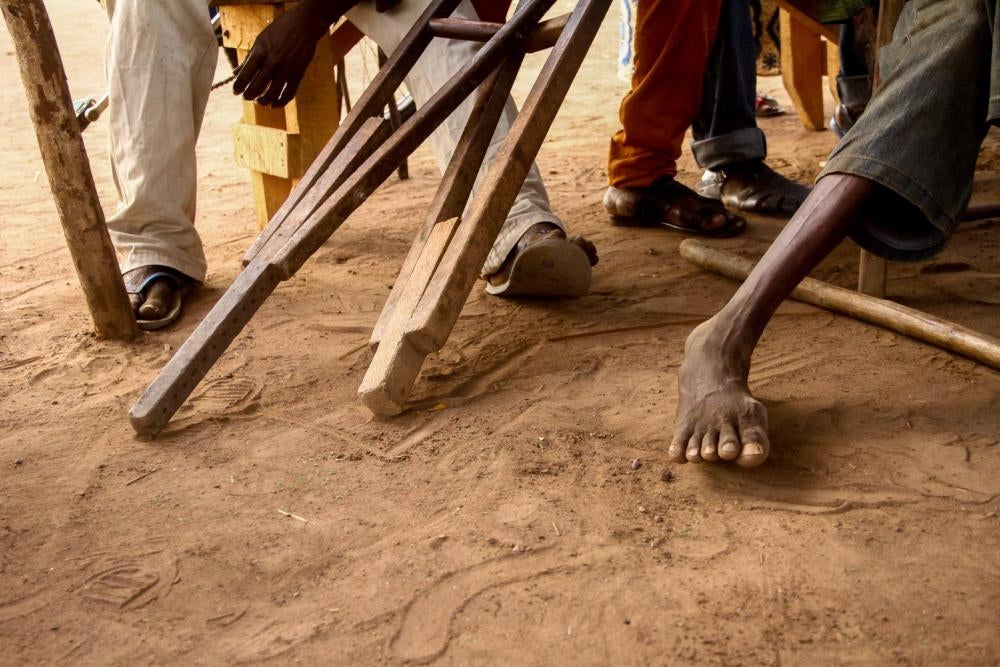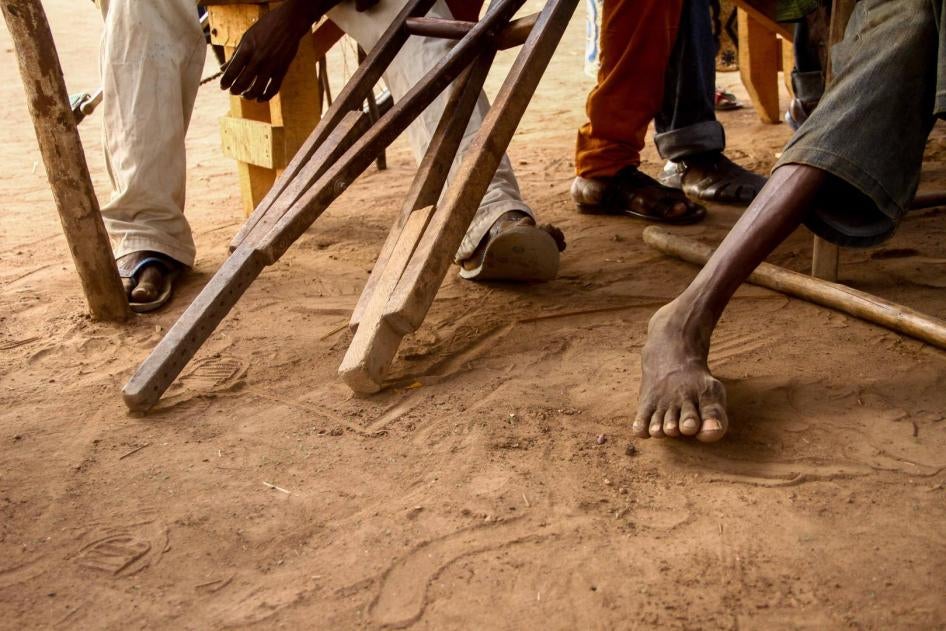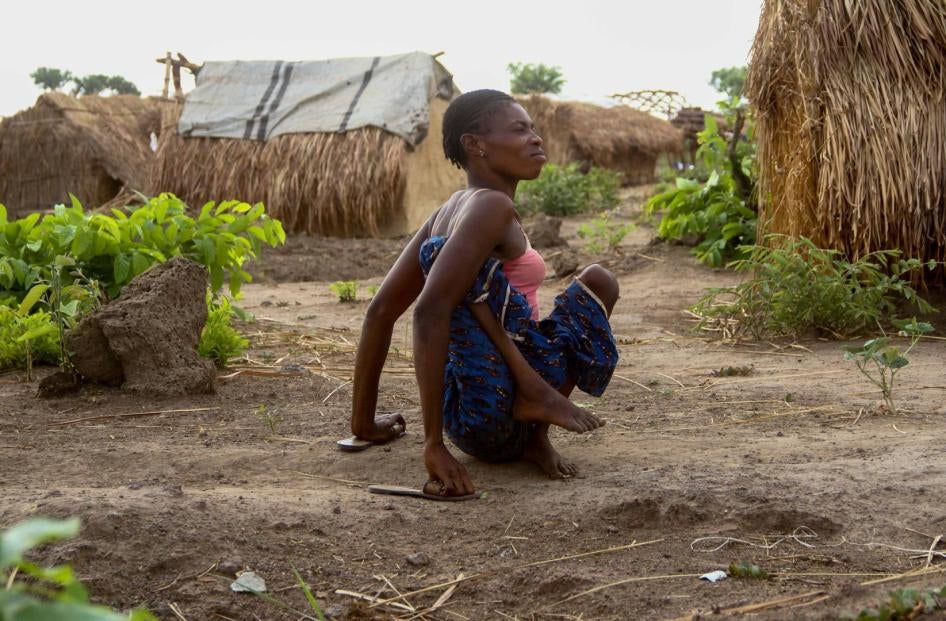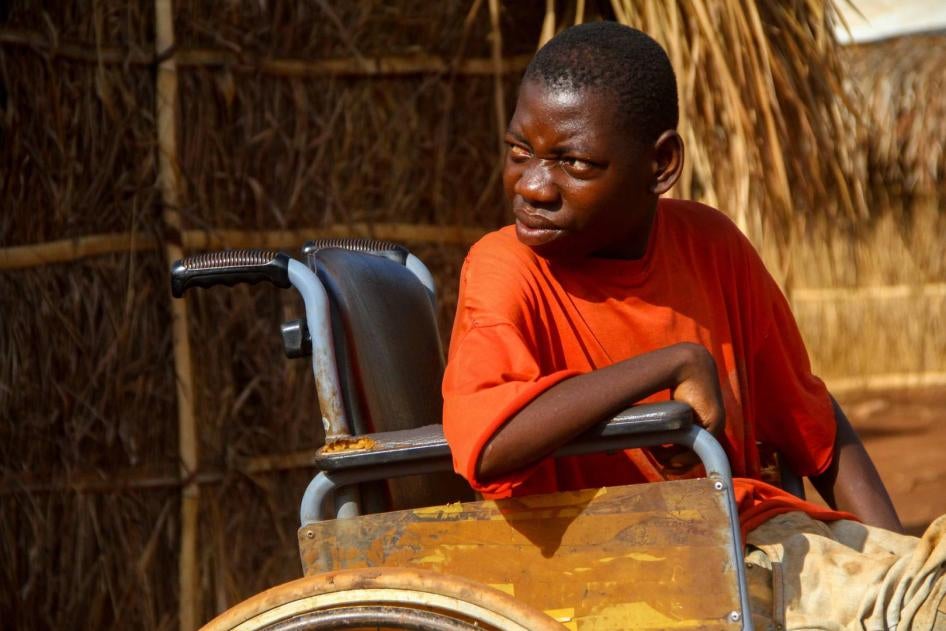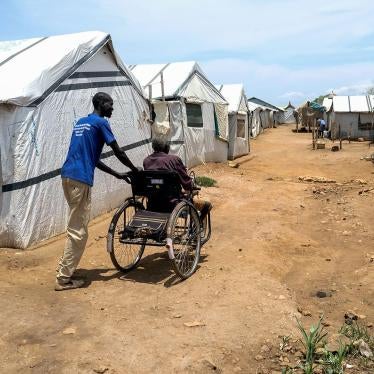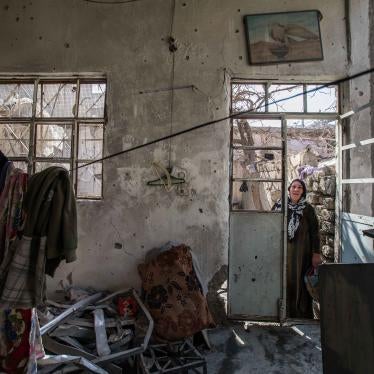(Nairobi, June 21, 2017) –People with disabilities in the Central African Republic have faced violent attacks, forced displacement, and ongoing neglect in the humanitarian response, Human Rights Watch said today. A peace accord signed on June 19, 2017, offers a chance to help this abused and marginalized group.
New Human Rights Watch research in the country shows that people with a range of disabilities are often unable to flee violence, are especially vulnerable to attack while trying to flee, and face unsafe and unhealthy conditions in displacement camps.
“The peace accord should bring a respite for civilians who have been brutalized in this conflict, especially people with disabilities who suffer violence and neglect,” said Lewis Mudge, Africa researcher at Human Rights Watch. “People with disabilities and other at-risk groups should get the protection and assistance they desperately need.”
In April 2017, Human Rights Watch interviewed more than 30 people with disabilities in Bambari and Kaga-Bandoro, two towns affected by a recent surge in violence. This research builds on an April 2015 report to reveal the ongoing abuse that people with disabilities face in the conflict.
To improve protection for people with disabilities, the United Nations peacekeeping mission, MINUSCA, and relevant United Nations bodies should monitor and report publicly about abuses against these people and dedicate resources to improving the limited humanitarian assistance that they receive, Human Rights Watch said. Governments should also urgently contribute to the UN’s humanitarian appeal for the Central African Republic.
In some cases, people with disabilities either could not or chose not to flee an attack. “Jacques” from the town of Wadja-Wadja said that fighters from a Seleka faction, the Union for Peace in the Central African Republic (l’Union pour la Paix en Centrafrique, UPC,) killed his friend “Spa,” a 40-year-old man with a physical disability, when they attacked the town of Yassine on March 20.
“Spa did not like his crutches because he felt they made him slow,” Jacques said. “When the attack started, he was not moving. I don’t know why. Maybe he thought he would not be killed because he had a disability. When I went back to Yassine I saw him dead. He had been shot in the chest. He was still in the same place I saw him when I fled.”
Human Rights Watch interviewed people with various physical disabilities who were threatened or shot at as they tried to flee fighting. One woman who cannot walk watched as her two children, 4 and 5, drowned while trying to cross a river alone.
On June 19, the government and 13 of 14 armed groups active in the country signed a peace accord mediated by the Roman Catholic Community of Sant’Egidio. The accord commits the parties to end their hostilities and to recognize last year’s presidential election results.
The accord is a step toward ending the conflict that should also promote accountability for grave crimes that were committed. This includes criminal prosecutions under the jurisdiction of the Special Criminal Court, a hybrid domestic court with local and international staffing, and the International Criminal Court (ICC), Human Rights Watch said. The accord takes note of both courts and calls for the creation of a Truth, Justice and Reconciliation Commission.
More than 500,000 people are living in camps for internally displaced people, and about 400,000 are refugees in neighboring countries. There is no data on the numbers and needs of people with disabilities.
For people with disabilities, either from before the conflict or due to injuries sustained during attacks, conditions in the internal displacement camps are particularly harsh. Camp residents receive limited aid but people with disabilities, especially those without family members, struggle to get food due to the often chaotic and disorganized nature of food distributions.
“At food distributions people fight and I have to crawl on the ground to find a little,” said “Yvonne,” a 55-year-old woman with a physical disability who fled fighting in Bakala and lives in the PK8 camp outside of Bambari. “Sometimes I don’t even have two beans.”
Others said they cannot access showers and toilets because they lack ramps and are too small for a wheelchair. “François,” who fled Ndassima, described his struggles at the PK8 camp. “The access to the toilets is so difficult,” he said. “I have to walk with my hands and I don’t have gloves. I must wrap my hands in tissue if I can find it. Most of the time I can’t find it. Honestly it makes me pity myself.”
Access to the camps is part of the problem. UN agencies and other aid groups are sometimes unable to get supplies to camps due to danger on the roads. The lack of resources presents another problem. A UN humanitarian appeal has received only 28 percent of its US$399 million target from donor nations.
While the UN and aid organizations are managing a complex crisis with limited means, they could do more to identify and report on the challenges to assist people with disabilities, and devise programs to address their plight, Human Rights Watch said.
Absent UN monitoring and reporting, the full impact of the conflict on people with disabilities remains unclear. A 369-page Mapping Report issued by the UN in May documents war crimes by all parties to the conflict from 2003 to 2015, but does not cover how people with disabilities have been affected by the fighting. Reports from the secretary-general also have not mentioned the conflict’s impact on people with disabilities.
“People with disabilities are suffering disproportionately in the Central African Republic and then falling through the cracks,” Mudge said. “Governments and the UN should dedicate more funds and improve the protection of civilians, with special attention to those in urgent need.”
Conflict in the Central African Republic
The Central African Republic has been in crisis since late 2012, when mostly Muslim Seleka rebels began a military campaign against the government of Francois Bozizé, seizing Bangui in March 2013. Their rule was marked by widespread human rights abuses, including the wide-scale killing of civilians. In mid-2013, the Christian and animist anti-balaka militia organized to fight the Seleka. Associating all Muslims with the Seleka, the anti-balaka carried out large-scale reprisal attacks against Muslim civilians in Bangui and western parts of the country.
In 2014, African Union and French forces pushed the Seleka out of Bangui and, by the end of the year, the Seleka had split into several factions, each controlling its own area. Since November 2016, the conflict has spread east as Seleka factions turned on each other. Conflict spread to the Ouaka province in December as some factions joined forces with anti-balaka groups in the area. In May, attacks by groups in Bangassou displaced thousands of people. Fighting between these groups remains a serious threat to civilians in the center of the country.
The government of President Faustin-Archange Touadéra struggles to maintain security and has little presence in areas outside the capital, Bangui, due to the activity of armed groups. The UN peacekeeping force in the country, the Multidimensional Integrated Stabilization Mission in the Central African Republic (MINUSCA), is the only force with the capacity to protect civilians. It has a mandate to use force, but has struggled at times to stop attacks or keep roads open. The force itself has increasingly come under attack, losing six peacekeepers in May.
On June 19, the Community of Sant’Egidio in Rome mediated a peace accord between the government and all of the armed groups active in the country except 3R (“Return, Reclamation, Rehabilitation,”) which reportedly could not attend due to logistical reasons. The accord calls for an immediate ceasefire in return for political representation, as well as the creation of a Truth, Justice and Reconciliation Commission with a 12-month mandate. The creation of a truth commission does not preclude investigations and prosecutions for war crimes by all parties, including in domestic courts, the Special Criminal Court and the ICC, which has a mandate to investigate grave international crimes in the country.
People with Disabilities Victims of Attacks
Clashes Around Bria: November 2016 – January 2017
On November 21, clashes broke out between two Seleka factions, the Popular Front for the Renaissance of Central Africa (Front Populaire pour la Renaissance de la Centrafrique, FPRC) and the Union for Peace in the Central African Republic (l’Union pour la Paix en Centrafrique, UPC) in Bria, the capital of the Haute Kotto province, over control of roads leading to diamond mines around Kalaga, a town 45 kilometers from Bria. The fighting left at least 115 combatants and 14 civilians dead and 76 civilians wounded, and displaced up to 10,000 people.
“Laurence,” a 55-year-old polio survivor who cannot walk, said he fled Ndassima, a gold mining center in the Ouaka province between Bria and Bambari, in January due to fighting:
I can’t walk fast and when we heard the shooting I told my family we had to leave. My family had to walk slowly to make sure I could make it. As we fled, one of my sons was killed five kilometers outside of town. He was 13-years-old. He was trying to help me move faster and he was hit by a bullet. It then took us five days to walk to Bambari…We had no food that entire time.
“Arun,” a 43-year-old Peuhl man with an intellectual disability, said he fled Bria in November after the fighting began. He was traveling with a group of about six people when FPRC fighters attacked:
When we were attacked in the bush, I was very scared. I thought I was already dead and it was hard to think. One of the attackers tried to shoot me and I don’t know why I am alive. I thought I had been struck by a bullet. I just ran. I don’t know how many days it took me to get to Ippy. I just walked.
Arun estimated that, because he was confused and disorientated, it took him at least a week to walk in the savannah woodlands to Ippy where he eventually found other Peuhl.
Kaga-Bandoro: October 11, 2016
On October 12, FPRC fighters and fighters from another group, the Central African Patriotic Movement (Mouvement Patriotique pour la Centrafrique, MPC), killed at least 37 civilians and wounded 57. The fighters razed the l’Évêché camp for displaced people in Kaga-Bandoro, forcing thousands of people to flee. About 7,000 people displaced by fighting in the region had been living in the camp. The attack was in response to the killing of a Seleka fighter the previous night, but tensions in Kaga-Bandoro had been high since September 16, when Seleka fighters killed six civilians in Ndomete, a town 10 kilometers away.
“Janet,” a resident of the Catholic Mission neighborhood, sought shelter at the home of a neighbor, Bakoudou Kankandi, who is deaf and does not speak. Seleka fighters soon broke down the door asking if there were men in the home, she said. Janet told them no but the fighters made everyone leave the house and go to the MINUSCA base. When they saw Kankandi, they got angry and shot him dead. “‘You said there were no men here – is this not a man?’ Janet recalled the Seleka fighters saying. “I said, ‘No, he is deaf and dumb, he does not understand.’ But they shot him anyway.”
At least three older people with disabilities were left behind at the displacement site and burned to death in the fire, survivors said.
A relative of Gilbert Bingimale, an older man with a physical disability, said that the family had to leave Bingimale in the hut so they could save the children. “It was burned down and when we came back later we found him still there,” the relative said. “He must have hidden thinking he would be safe. All his skin had burned off.”
A relative of Pauline Pharama, a 70-year-old blind woman, said he could not reach Pharama after the attack started. He said he returned the next morning and found her body charred and eaten by dogs.
Ouaka, Ouham and Nana-Grébizi Provinces: 2014 – 2015
On November 10, 2014, UPC fighters entered Bolo, a town in the Ouaka province, residents said. They immediately started shooting at people, causing villagers to flee. At least 11 people were killed, including at least two people with disabilities. A witness to the attack, “Léonard,” said:
Isaac Kimari was paralyzed and could not move. When the Seleka came they burned homes and Isaac was still inside his. Two of his family members, Henrietta Achie and Ange Lebaja, stayed and died in the house with him. We don’t know why they decided to stay.
Another man with a physical disability, Justin Jemafou, was also killed in the attack. “Justin could not move a side of his body,” Léonard said. “He was killed trying to crawl away.”
In November 2014, anti-balaka forces from Pende attacked Ngbima in the southern Ouaka Province. According to 10 residents, on November 25 they killed 28 civilians in Ngbima, including a 25-year-old woman with a physical disability named Yassimara. Her husband said:
Yassimara was born with a bad foot. She could walk on it, and she could only move with a cane and could only move slowly. We were at home when the attack started. It was early in the morning and we heard the shots. I saw people running out of their homes. I heard the anti-balaka shouting, “Take Ngbima! Attack!” I ran to the bush, but my wife stayed at the house. I did not have time to get her. I just hoped she would be okay. They burned the house with her in it, she never tried to run. After the attack we found some of her bones and buried them.
In the village of Bizomo in February 2015, on the road between Batangafo and Kaga-Bandoro, Peuhl fighters killed Paul Orogbia, a 70-year-old man who was blind. A relative of Orogbia said:
When the village was attacked, he [Orogbia] refused to move. He said, ‘Where do you want to take me? I don’t have any strength and I am blind.’ He said he preferred to stay and die. We returned to the village during the night and found his body – he had been shot. We buried him the same night.
Some people acquired disabilities from Seleka attacks. “Maurice,” a 35-year-old man from Bokandji, near Botto in Nana-Grébizi province, was captured by the Seleka in 2014. As the Seleka looted his home they asked him where he hid his money. He insisted that he had none:
One of the Seleka said, ‘Let’s cut his throat.’ But another said, ‘No, if we do that he won’t really feel death.’ They tied me up with my hands to my feet behind my back and threw me into a cooking fire. I tried to roll out but they pushed me back into the fire. My right side was on the fire and they stepped on me to push me into it. I lost consciousness. When I woke up I was at the hospital. The doctors wanted to amputate my right arm, but my mother refused. It is now useless.
Dangers of Displacement
In areas under attack, people are often forced to flee their homes to save their lives. They face dangers when displaced but people with disabilities, particularly physical disabilities, are at even higher risk.
“Jeanette,” a 27-year-old woman with a physical disability, had to flee her home in Ngoulekpa I, in the Nana-Grébizi province, in 2014 when the Seleka attacked. Her father was killed in the attack and her mother fled without her, leaving her alone with her two children. She said:
The Seleka started to burn the house so we had to flee. My kids [4 and 5 years old] were young and I was moving on my hands, so we were slow. Nobody could help us. We got to a stream and my children tried to cross it. But they could not swim and the water was too deep. I watched as they both drowned. I then had to crawl to Kaga-Bandoro.
Yassine: March 20, 2017
On March 21, fighters from the UPC attacked a group of several hundred displaced people in the largely undefended town of Yassine.
“Fidel,” a 55-year-old resident of neighboring Wadja Wadja, who has a physical disability, said he fled into the surrounding woods. “I was running with crutches and I’m lucky to be alive,” he said. “I was moving slowly with the crutches, but I managed to hide in the bushes. I tried to push myself back but I fell into a stream.”
“Blandine,” a 30-year-old woman with a physical disability caused by polio, said she pretended to be dead during the attack on Yassine because she could not run away. “Everyone ran and nobody would help me,” she said. “I just stayed on the ground and put my face in my hands. I heard screaming and shooting.” As UPC fighters looted Yassine, they found Blandine, stole her belongings, and told her to leave, she said. While leaving Yassine, she said she saw at least seven dead children, three dead women and four dead men. She crawled to Agoudou-Manga, seven kilometers away, and waited for three days before a truck came that could transport her to Bambari.
Bakala: December 11, 2016
On December 11, as fighting raged between the UPC and the FPRC, the UPC temporarily took control of Bakala, a town close to several gold mines in the Ouaka province. As the UPC attacked they quickly started to kill civilians, associating them with either FPRC sympathizers or anti-balaka.
“Monica,” a 30-year-old polio survivor who cannot walk, lost her husband and three children in the fighting:
During the attack, I went into the house to hide. My husband and I agreed beforehand that if there was an attack he would take the kids into the bush and hide. He told me to stay in the house and he left. The Peuhl [UPC] chased them into the bush and shot them all. After the attack, I wanted to look for my family so I crawled into the bush toward the river. I spent two days there until a neighbor came and told me my family was dead. He helped me get to Bambari. My children were 4, 3, and 2 years old.
“Francis,” a 16-year-old boy with a physical disability, fled Bakala with his family when the attack began. “There was shooting everywhere,” he said. “My father just threw me into my wheelchair and he pushed me as fast as he could.” Once out of town, Francis’ father pushed him 75 kilometers in his wheelchair, which Francis still has at the PK8 camp in Bambari, where he lives. “It took us three days,” he said. “When it was dangerous my father would hide me in the bush and move ahead alone to make sure it was safe. We had no food and no water during that entire time.”
Kaga-Bandoro: October 11, 2016
“Remy,” a 36-year-old man with a physical disability, said he has had trouble thinking clearly and expressing himself since he lost his arm in a grenade explosion in 2015. “I start to tremble when I am in the sun and I can’t walk [well],” he said. During the attack on the l’Évêché camp Remy was alone:
I don’t like to be in crowds, I preferred to stay in the hut alone. When I heard the attack, I was alone and I did not know where to go. I went outside. It was confusing. I could not move and I just stood there. I think I would have been killed had someone, I don’t know who, not grabbed me and made me run. He just told me to run or I would die.
“Clarise,” a 30-year-old mother of six who cannot walk, fled Ngououaka I for Kaga-Bandoro in 2014, a 15-kilometer journey that she said took one week and that she had to make alone, slowly crawling on her hands. She was also at the l’Évêché camp when it was attacked. She said:
When I saw they were burning huts I knew we had to run. I told my kids to leave me so they could move fast. I then followed by myself, moving with my hands. Bullets were going past me and I saw Seleka killing people. Then I was trapped by the smoke of the burning huts, but I just kept moving forward. It is by the grace of God that I managed to escape.
“André,” a 60-year-old polio survivor who cannot walk, said he fled the Kaga-Bandoro camp when he heard shots. “I knew I had to run as there was nobody to help me,” he said. “I had to flee on my hands, I saw dead people all around me. I was not helped by anyone and I was very scared. At any moment, the Seleka could have just shot me as well.”
“Michel,” a 35-year-old with a similar physical disability, had a similar experience and fled the Kaga-Bandoro camp using his hands. “I was abandoned by my family,” he said. “It was everyone for himself, so I had no choice but to move or die.”
Some people with disabilities had assistance when fleeing attacks. “James,” a 38-year-old man with a physical disability, said his brother carried him to safety when the l’Évêché camp was attacked. But he said that some people with intellectual disabilities apparently did not know they should flee. “Laurence,” a 29-year-old man with an intellectual disability, said he was abandoned when the camp was attacked. “When the huts were burning I stood there and watched them,” he said. “I did not like to see them burning, but I wanted to wait to see if our hut would burn.” His father ran back for him amid the fighting and took him to safety.
Fleeing Before the Fighting
Some people with disabilities said that, as the violence spread, they fled their homes preventively, before the fighting arrived.
“François,” a 45-year-old man with a physical disability from Ndassima, explained why he decided to leave for Bambari:
It was in 2015. The UPC were saying that useless people that could not work in the gold mine should leave. They told me, ‘If you stay here we will lock you in a house and burn you alive in it.’ I had no choice. I can’t run away, so I walked to Bambari. I used to sell things in Ndassima, I was not useless as they said. I would like to do business again, but I have nothing here. I do nothing during the day.
“Florence,” a 23-year-old woman with physical disabilities, said she fled Bakala in the days before the fighting when she heard rumors of an impending attack. She had to get to Bambari, 75 kilometers, using her hands as she did not have crutches. It took her several days.
“Salé,” a 42-year-old Peuhl man who was shot by anti-balaka fighters and severely injured his foot during an attack near Ngakobo in early 2015, said his health was deteriorating so he decided to go to Bambari. “First the anti-balaka targeted the Peuhl, but now the coalition [FPRC and anti-balaka] are targeting us,” he said. “I knew that if there was another attack I would not be able to run.”
Life in the Camps
More than 503,000 people are living in camps for internally displaced people in the center and eastern part of the country, most of them receiving assistance from the UN and other aid groups. In April, Human Rights Watch conducted research in five displacement camps in two of the larger towns in the east, Bambari and Kaga-Bandoro. All the camps were receiving limited humanitarian assistance, such as tents, food, and medicine. There, people with disabilities, many of whom had survived violent attacks, face daily hardships, in particular when it comes to sanitation and food.
Water and Sanitation
Access to water and sanitation services, such as latrines and showers, is a daily struggle for people with disabilities in the eastern camps. Without ramps, bars, and other support, some people with physical disabilities must crawl on the ground to enter these areas, exposing them to health risks.
“Emmanuel,” a 38-year-old man who was injured when he fell while fleeing a Seleka attack in 2015 and now cannot walk, described the obstacles to using the toilet at the Lazare camp in Kaga-Bandoro. “I have to sit on the ground where other people defecate,” he said. “I don’t have gloves so I just try to wash my hands afterward. I don’t feel like a human being.”
“Michel,” 35, who is in the “MINUSCA” camp in Kaga-Bandoro, said that after almost four years, he has given up on getting services at the camp. “I can only go to relieve myself in the bush; I must go on my hands,” he said. “But now the new camp has been here for so long and people are defecating in the bush on the perimeter of the camp, so I find myself crawling through other peoples’ feces.”
“Monica,” 30, described similar difficulties at the PK8 camp in Bambari. “I have to use the toilet in the bush because I don’t have anything to protect my hands in the camp toilets,” she said. “In the bush I sometimes crawl through other peoples’ feces. These conditions make me sick because it is so dirty.”
“Geraldine,” a 70-year-old blind woman living alone in the PK8 camp in Bambari, said she has almost burned herself by walking into open fires and often struggles to find a toilet. “I’m alone and it is difficult for me to find the toilets,” she said. “Sometimes I have people help me, but usually I just find my way into the bush on the outside of the camps.”
“Florence,” a 36-year-old woman with a physical disability living in the PK8 camp, said:
To wash myself I must wait until it is night and I do it by my hut because I can’t get to the shower. I deplore these conditions of life, but I have no power to change it so I have had to get used to it.
Food distribution can be sporadic at displacement camps in Bambari and Kaga-Bandoro and people with disabilities, especially those without families, often struggle to obtain supplies in the chaos during disorganized distributions.
“It is very difficult to get food when it is distributed,” said 40-year-old “Thierry,” a man with a mobility disability who lives at the “MINUSCA” camp in Kaga-Bandoro. “Everyone is mixed and people start to fight with each other after a few minutes, so we people with disabilities must watch from the sidelines and just try to get what is left over.”
UN Peacekeepers’ Mandate
In April 2015, when the UN Security Council renewed the peacekeepers’ mandate, it expressed for the first time “serious concern about the dire situation of persons with disabilities in the CAR including abandonment, violence and lack of access to basic services.” The mandate stressed the need for the humanitarian response to address “the particular needs of persons with disabilities.” The Security Council specifically mandated MINUSCA to monitor, investigate, and report on abuses against persons with disabilities. When the Security Council renewed the mandate one year later, in April 2016, the language on people with disabilities was dropped.
Despite abundant evidence that people with disabilities are particularly at risk of attacks and abuse in the Central African Republic, monitoring and reporting efforts still fail to include this vulnerable group. MINUSCA’s report on human rights in the country from June 1, 2015, to March 31, 2016, for example, does not include any information about abuses committed by armed groups or government forces on people with disabilities.
Likewise, while the independent expert on the human rights situation in the Central African Republic mentioned the situation for people with disabilities affected by the conflict in her July 2015 report, the next year’s report did not include the issue. The secretary-general’s annual reports to the Security Council on children and armed conflict have covered the Central African Republic since 2016, but not explicitly included information on children with disabilities.
The 369-page comprehensive UN Mapping Report documents serious violations of human rights and international humanitarian law in the country from 2003 to 2015. The report covers 620 crimes “of the most serious gravity” by various parties but does not identify the crimes of which people with disabilities were victims.
The next renewal of the peacekeeping mandate is to be in November.
Recommendations
To the government of the Central African Republic
- Identify, register and include in any data collection efforts information on people with disabilities and their needs;
- With international partners, develop an action plan to include and support people with disabilities and their local representative organizations in the humanitarian response to the crisis, especially in the eastern part of the country; and
- Ensure access to basic services for people with disabilities in internal displacement camps. Provide priority and/or separate access to food and sanitation services for displaced people with disabilities in the camps.
To the UN Mission in Central African Republic (MINUSCA)
- Assist the government in data collection efforts on people with disabilities and their needs; and
- Include people with disabilities in human rights reporting.
To UN Agencies and Aid Organizations
- Assist the government in data collection efforts on people with disabilities and their needs;
- Ensure equal access to basic services for people with disabilities in internal displacement camps. Provide separate access to food and sanitation services for people with disabilities in the camps;
- Ensure the participation of persons with disabilities in the design, implementation, and monitoring of programs, strategies, and action plans that eliminate barriers to inclusion; and
- Ensure that facilities in displacement camps, including access to sanitation facilities, are accessible to people with disabilities.
To the UN Security Council
- Request periodic reports, including from the secretary-general, on the situation of people with disabilities.
To Donors, including the European Union and its member states
- Ensure the inclusion of people with disabilities in humanitarian assistance by requiring that all aid is accessible; and
- Request implementing partners to report on beneficiaries with disabilities.
